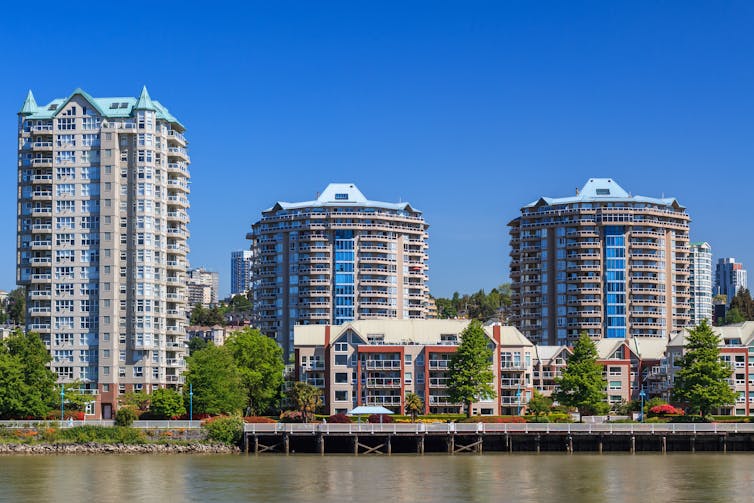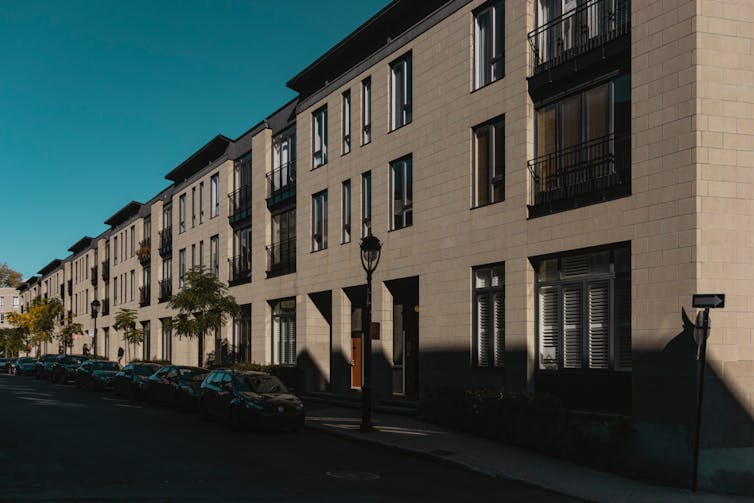
Cities like Vienna or Singapore are often referenced in news headlines proposing solutions for Canada’s housing crisis. But the arguments in favour of the strategies employed by these far-away cities often only skim the surface and can be easily dismissed with a response of “this will never work here.”
There is a degree of truth to that: Vienna’s much-lauded affordable housing situation today is built on a legacy of more than 100 years of prioritizing social housing.
In Canada, social housing constitutes only 3.5 per cent of our supply, which is half the OECD average, and a number so low, even Scotiabank is concerned.
While foreign cities offer examples of how things can be different, it’s far more productive to look at what we’re already doing here in Canada. Fortunately, there are many Canadian examples that are shifting housing away from a speculative commodity, and towards a human right.
Read more: Housing is both a human right and a profitable asset, and that's the problem
Pathways to solutions
I spent much of the summer going across the country to learn about some of these solutions. Most are small and none are perfect (neither are the often-cited foreign examples, by the way). But they all offer pathways to a more socially just housing system.
Here are four examples of Canadian initiatives we need to pay more attention to:
1. Whistler Housing Authority
This independent, municipally owned corporation was established to oversee the development, administration, and management of price-controlled real estate and employee-restricted housing in Whistler, B.C. It offers properties for both sale and rent, with strict rules on selling prices, and rents that are set at 30 per cent of a tenant’s income.
This was all possible because the WHA uses public land, where it is easier to think beyond the market and establish more ambitious affordability targets compared with land owned by private developers. This means that new supply is geared to what residents can afford, not what is most profitable.
2. New Westminster’s anti-renoviction bylaw
Renovictions are a major contributor to the erosion of affordable housing. In 2019, New Westminster, B.C., passed an anti-renoviction bylaw that fined landlords up to $1,000 a day. To comply, landlords had to both demonstrate it was necessary for the tenant to vacate their unit for renovation work, and provide tenants with a written offer to return to the unit at the same price.
Read more: Cities must take immediate action against 'renovictions' to address housing crisis
The result: while there were over 300 renovictions in the three years prior to the bylaw, there were none the year after. New Westminster has shown other communities across the country how they can eliminate this unjust and cruel practice. In 2021, the B.C. government updated its Residential Tenancy Act to bring in similar rules provincewide.

3. Burnaby’s tenant assistance policy
Burnaby, just outside Vancouver, has taken action against both renovictions and demovictions, and arguably has the best tenant protection policies in Canada.
There are four key elements to its Tenant Assistance Policy: the right to return to a similar unit at roughly the same rent when the work is finished; the developer or landlord is obliged to help tenants find interim housing if needed; the rezoning applicant must pay a top up fee to cover any additional rental costs tenants incur with their interim housing; and financial assistance to tenants to cover moving costs.
Burnaby’s rules are far more prescribed and detailed than any other in Canada. And they place the onus of responsibility firmly on the landlord to ensure tenants can return. This is not the case in Ontario, where tenants also have the right to return, but few are able to do so.
Burnaby also has other rules to ensure a steady supply of new affordable housing, and this has not led to a drop in new construction. Development is booming, supply is growing and tenants are not displaced to make way for it.
4. Montréal’s pre-emptive right policy
In 2016, the City of Montréal was given the pre-emptive right to acquire property and it has identified 350 properties where it can exercise this right. Generally, these are low-rent buildings in gentrifying neighbourhoods.
If one of these properties is sold on the open market, the city has 60 days to match that offer and buy the site for the same price agreed by the private buyer.
The policy has a small budget, which limits its impact, but acquisition strategies that decommodify housing are essential tools to address the rental crisis.

Rent control strategies are effective
Rent control is a set of rules guiding how much and when landlords can increase rent. In most cases, sitting tenants benefit from rent control, but there’s one major loophole: when a tenant leaves, landlords can raise the rent to whatever they want. In Ontario, vacancy control was abolished by the Mike Harris government in 1996.
This creates a financial incentive for landlords to evict sitting tenants, which can make life miserable.
It also contributes to the loss of affordable housing — in cities such as Hamilton, Ont., more than 20 units are lost for every new one constructed.
While there’s a hybrid model in Manitoba that has helped to moderate rent increases, Prince Edward Island is the only province that has full vacancy control. In this unit-based system of rent control, rules are governed by the Island Regulatory and Appeals Commission (IRAC), which sets permitted increases at around one to two per cent per year regardless of whether the unit is vacant or occupied.
There are loopholes, such as the fact that new tenants have no formal way of knowing what the previous tenant paid, and the ease at which landlords can be granted above-guideline increases. But these are reasons to strengthen rent control, not water it down.
Many housing advocates and researchers agree that implementing vacancy control across the board would have the most beneficial impact on tenants. And despite what developers and landlords might cry out, there’s little empirical evidence to indicate regulating rents leads to a decline in new construction.
The beauty of rent control is that it doesn’t cost taxpayers anything to implement. While new supply needs to keep pace with population growth, keeping existing housing affordable is essential. With the right vision and political will, vacancy control could be implemented tomorrow. And just like the other examples I’ve discussed, we don’t need to look overseas for inspiration on how to do it.
Brian Doucet receives funding from SSHRC, the Canada Research Chairs program and the Hamilton Community Foundation. Some of his research is conducted in partnership with the Social Development Centre Waterloo Region. He has co-written reports on housing and mobility for local governments in Ontario.
This article was originally published on The Conversation. Read the original article.







